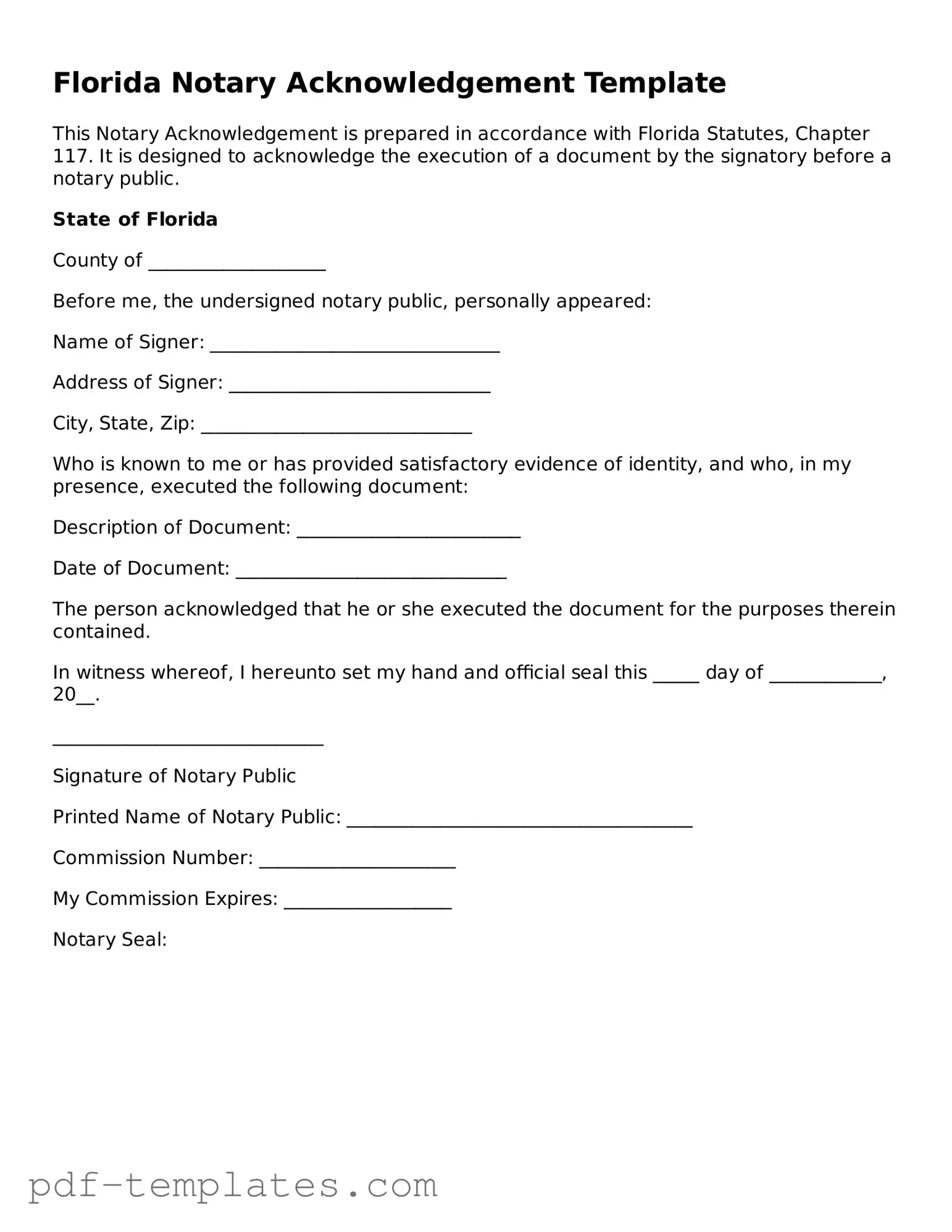The Florida Notary Acknowledgment form is similar to the Affidavit. An affidavit is a written statement confirmed by oath or affirmation, used as evidence in court. Like the acknowledgment form, it requires a notary to witness the signature of the affiant, ensuring that the individual signing is doing so willingly and under oath. This adds a layer of authenticity and can be used in various legal proceedings.
Another document that shares similarities is the Power of Attorney. This document allows one person to authorize another to act on their behalf in legal matters. Both the Power of Attorney and the Notary Acknowledgment require notarization to confirm that the signatory is indeed the person they claim to be, thereby preventing fraud and ensuring the validity of the document.
The Deed is also comparable to the Notary Acknowledgment form. A deed transfers ownership of property from one party to another. Just like the acknowledgment form, a deed must be signed in the presence of a notary public, who verifies the identities of the parties involved. This ensures that the transfer of property is legitimate and legally binding.
Similar to the Notary Acknowledgment is the Certification of Trust. This document provides proof of a trust's existence and outlines its terms. Notarization is often required to validate the identities of the individuals involved, ensuring that the trust is being managed according to the wishes of the trustor, much like the acknowledgment process protects the intent of the signatory.
The Bill of Sale is another document that requires notarization and is similar to the Notary Acknowledgment. This document transfers ownership of personal property from one person to another. A notary public verifies the identities of both parties and their willingness to enter into the transaction, similar to how the acknowledgment form works to confirm the signer's intent.
The Last Will and Testament also resembles the Notary Acknowledgment form. This document outlines a person's wishes regarding the distribution of their assets after death. While not all states require notarization for wills, having a notary involved can help verify the identity of the testator and ensure that the will is executed in accordance with legal standards, much like the acknowledgment form confirms the intent of the signer.
The Lease Agreement is another document that shares characteristics with the Notary Acknowledgment. This contract outlines the terms under which one party rents property from another. Notarization can add credibility to the lease, confirming that both parties have willingly entered into the agreement and understand their obligations, similar to how the acknowledgment form validates the signer's consent.
Similarly, the Loan Agreement requires notarization to confirm the identities of the parties involved. This document outlines the terms of a loan between a lender and a borrower. The notary's role is to ensure that both parties understand and agree to the terms, just as the Notary Acknowledgment form serves to affirm the intent of the signer.
If you're looking to authorize someone to handle your financial affairs, you may find our guide on navigating the General Power of Attorney necessary for your situation. Be sure to review the details found in the General Power of Attorney document checklist to understand its implications fully.
The Marriage License is also akin to the Notary Acknowledgment. This document allows a couple to legally marry. A notary may be involved in the process to verify the identities of the individuals applying for the license, ensuring that they are entering into the marriage willingly and with full understanding of the legal implications, similar to the acknowledgment process.
Lastly, the Mortgage Agreement is comparable to the Notary Acknowledgment form. This document secures a loan with the property being purchased. Notarization is often required to confirm the identities of the borrower and lender, ensuring that the agreement is valid and enforceable, much like the acknowledgment form verifies the intent and identity of the signer.
